Introduction
Have you noticed more young people wearing brightly colored or mismatched socks? That’s not random—it’s a trend driven by Gen Z. This generation is rewriting the rules of sock fashion. Instead of hiding socks under pants, Gen Z proudly shows off bold patterns, vintage styles, and even deliberately mismatched pairs. In this article, we’ll explore what socks Gen Z wears, why they choose these styles, and how brands can keep up with this fast-changing trend.

Color Trends and Pattern Play: Vibrant Gen Z Sock Styles
Gen Z Sock Color Trends: Bold, Bright, and Unapologetic
Gen Z’s sock color preferences defy traditional fashion norms. Bright, saturated hues like neon greens, electric blues, and fiery oranges dominate their choices. These colors are not about subtlety but about making a visual impact. Gen Z embraces clashing colors that create intentional contrasts and draw attention.
Maximalist Sock Patterns: Why Gen Z Loves Visual Complexity
Along with bold colors, Gen Z favors complex and layered patterns. From geometric shapes to nostalgic retro designs and digital culture motifs, their socks often tell stories. Maximalist patterns offer visual interest from across the room, making socks conversation starters rather than mere accessories.
Brands that combine striking colors with layered patterns resonate well with Gen Z consumers seeking to express individuality through their sock choices.
Sustainability in Gen Z Socks: How Eco-Friendly Materials Influence Buying
Sustainability is a key factor in Gen Z’s sock purchasing decisions. This generation prioritizes eco-friendly materials such as organic cotton, recycled polyester, and fibers derived from bamboo or eucalyptus. They expect transparency in production methods and brand ethics.

Many Gen Z consumers are willing to pay a premium for socks that align with their values of environmental responsibility. Brands that highlight sustainable sourcing and manufacturing practices can deepen trust and loyalty among this demographic.
Popular Gen Z Sock Styles and Crew Sock Height Preferences
Crew Socks: The Dominant Sock Height in Gen Z Fashion
Crew socks, typically 6 to 8 inches above the ankle, are the most popular height choice among Gen Z. This length offers a perfect canvas for bold designs and ensures maximum visibility. Crew socks pair well with popular footwear styles like chunky sneakers, slides, and boots, making them versatile for various looks.
Other Styles and Market Presence
While crew socks dominate, no-show and ankle socks see less popularity because they hide designs. Knee-highs and other longer styles have niche appeal, mainly for fashion-forward consumers. Brands should focus on high-quality crew socks with comfortable fits that support Gen Z’s styling preferences.
Strategic Mismatching: Gen Z’s Favorite Sock Styling Rule
Deliberate mismatching of socks has become a hallmark of Gen Z style. Unlike accidental pairing mistakes, strategic mismatching involves combining socks that share connecting elements—colors, themes, or patterns—while maintaining intentional differences.
This trend challenges longstanding fashion norms and signals confidence and creativity. Mismatched socks often pair with footwear like sandals or boots to create distinctive, eye-catching looks.
Brands can capitalize on this by offering complementary mismatched pairs or encouraging customers to experiment with their styling.

Social Media Influence and DIY Custom Socks Trends Among Gen Z
How Social Media Drives Gen Z Sock Trends
Platforms like TikTok, Instagram, and Pinterest play crucial roles in shaping Gen Z sock trends. Visual content showcasing bold sock styles and unique pairings spreads quickly, inspiring young consumers worldwide to try new looks and share their own.
DIY Custom Socks and Subscription Services: Engaging Gen Z Buyers
Customization is another rising trend. Gen Z enjoys personalizing socks through tie-dye, embroidery, or fabric paint, reflecting a desire for unique, one-of-a-kind items. Subscription services delivering curated sock selections cater to this audience’s appetite for discovery and novelty.
Brands that offer “blank canvas” socks and subscription options tap into these consumer preferences, building deeper engagement.
Conclusion: Understanding Gen Z Sock Trends to Meet Market Demands
Gen Z has revolutionized how socks fit into fashion, elevating them from functional basics to key style statements. Their preferences for bold colors, maximalist patterns, sustainability, and creative styling present opportunities for brands to innovate and connect.
Retailers and manufacturers who embrace these trends and offer products aligned with Gen Z’s values and aesthetics will be better positioned to capture this growing market segment. If you’re looking for products that align with the latest Gen Z sock trends, check out our custom socks collection, featuring diverse patterns and color options.
FAQ
What sock heights are most popular in Gen Z sock trends?
Crew socks, extending 6 to 8 inches above the ankle, are the dominant preference, offering visibility and design space.
Are bold and mismatched socks acceptable in professional settings?
Acceptance varies by industry. Creative and casual workplaces often welcome expressive socks, while traditional environments may require conservative choices.
How important is sustainability in Gen Z sock buying decisions?
Sustainability is a significant factor. Many Gen Z consumers prefer eco-friendly materials and ethical production practices, even at a higher price.
Why is strategic mismatching a key Gen Z sock trend?
It allows individuals to showcase creativity and confidence, breaking traditional matching rules with intentional style.
Are DIY and subscription sock services growing in popularity?
Yes. DIY customization and subscription models cater to Gen Z’s desire for personalized, novel sock experiences.
